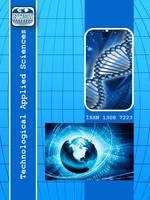AISI 304 ÖSTENİTİK PASLANMAZ ÇELİĞİN TORNALANMASINDA YÜZEY PÜRÜZLÜLÜĞÜNÜN VARYANS ANALİZİ İLE MODELLENMESI
Bu çalışma, AISI 304 Östenitik paslanmaz çeliğinin tornalanması sırasında yüzey pürüzlülüğünün modellenmesi ve optimizasyonu için yapılmıştır. Deney numuneleri 1050°C’de 60 dakika tavlanmış ve suya çekilmiştir. Daha sonra tavlanmış numuneler 700°C’de sırası ile 30, 90 ve 240 dakika bekletilmiş ve ardından oda sıcaklığında soğutulmuştur. Deneysel çalışmalar farklı kesme hızları, ilerleme miktarı ve bekleme süresi esas alınarak yapılmıştır. Tornalama işleminde CCMT09T308-41 kesme takımı kullanılarak yüzey pürüzlülüğünün ölçümünde tam deneysel çalışma, sinyal gürültü oranı ve varyans analizi yapılmıştır. Yapılan analizler sonucunda, yüzey pürüzlülüğüne etki eden en önemli faktörün ilerleme oranı, bekleme süresinin ikinci ve en az etkili olan parametrenin ise kesme hızı olduğu tespit edilmiştir. Aynı zamanda yüzey pürüzlülüğünü modellemek için doğrusal olmayan regresyon metoduda kullanılmıştır. Regresyon modelinin yüksek korelasyon katsayısının (0.95), gerçekleştirilen modelin yüzey pürüzlülüğünü modellemek için yeterli ve deneysel sonuçlar ile analiz sonuçlarının uyumlu olduğu görülmüştür.
Anahtar Kelimeler:
AISI304, Yüzey Pürüzlülüğü, Varyans Analizi, Regressyon Analizi, Östenitik Paslanmaz Çelik
MODELLING OF SURFACE ROUGHNESS WITH VARIANCE ANALYSIS IN TURNING OF AISI 304 AUSTENITIC STAINLESS STEEL
In this study, an attempt has been made to optimize and model to surface roughness when turning AISI 304 austenitic stainless steel. The as – received specimens were annealed at 1050˚C for 60 minutes and water quenched. Annealed specimens were then tempered at 700˚C for 30 90 and 240 minutes respectively and followed by room cooling. The experimental studies were conducted under varying cutting speed, feed rate and holding time. A full factorial experimentation, the signal – to – noise (S/N) ratio and the analysis of variance (ANOVA) were employed to the study the surface roughness in turning AISI 304 using CCMT09T308 – 41 insert cutting tools. The conclusions revealed that the feed rate was the most important factor on the surface roughness, whereas holding time was the second ranking factor and cutting speed was the least. A non – linear regression method was also used to model the surface roughness. The high correlation coefficient (0.95) of regression model showed that the model can adequately describe the performance within the limits of factors being studied. The experimental and predicted values were in a good agreement.
Keywords:
AISI304, Surface Roughness, ANOVA, Regression Analysis, Austenitic Stainless Steel,
___
- 1. Trent, E.M., (1991). Metal Cutting, Butterworth/Heinemann, London, 273.
- 2. Paro, J., Heanninen, H. and Kauppinen, V., (2001). Tool wear and machinability of X5 CrMnN 18 18 stainless steels. J Mater Process Technol; 119 (1–3):14–20.
- 3. Sullivan, D.O. and Cotterell, M., (2004). Machinability of austenitic stainless steel SS303, Journal of Materials Processing Technology, 124, 153 – 159.
- 4. Jiang, L., Roos, A. and Liu P. (1997). The influence of austenite grain size and its distribution on chip deformation and tool life during machining of AISI 304L, Metall. Mater. Trans.; 28, 2415–22.
- 5. Ersan, A., Necip, C., and Burak, B., (2007). Design optimization of cutting parameters when turning hardened AISI 4140 steel (63 HRC) with Al2O3 + TiCN mixed ceramic tool Materials and Design 28, 1618–1622
- 6. Korkut, I.K, Mustafa., Ciftçi, I., and Seker, U., (2004). Determination of optimum cutting parameters during machining of AISI 304 austenitic stainless steel Materials and Design 25, 303–305
- 7. Erdogan, K., Abdullah, K.S., and Ulvi, Ş., (2008). The effects of the feed rate on the cutting tool stresses in machining of Inconel 718, journal of materials processing technology 196, 165–173
- 8. Ciftci, I., (2006). Machining of austenitic stainless steels using CVD multi–coated cemented carbide tools”, Tribology International, 39, 565 – 569.
- 9. Nasr, M.N.A., Ng, E.G. and Elbestawi, M.A., (2007). Modeling the effects of tool–edge radius on residual stress when orthogonal cutting AISI 316L”, International Journal of Machine Tools and Manufacture, 47, 401–411.
- 10. Selinder, T.I., Sjöstrand, M.E., Nordin, M., Larsson, M., Östlund, A., and Hogmark, S., (1998). Performance of PVD TiN/TaN and TiN/NbN superlattice coated cemented carbide tools in stainless steel machining”, Surface and Coating Technology, 105, 51–55.
- 11. Tool-Life Testing with Single-Point Turning Tools, International Standards, ISO 3685-1977 (E), International Organization for Standardizations, Geneva. 1977.
- 12. Hasçalık, A. and Çaydaş, U., (2008). “Optimization of turning parameters for surface roughness and tool life based on the Taguchi Method”, International Journal of Advanced Manufacturing Technology, 38: 896-903.
- 13. Ross, P.J., (1998). Taguchi technique for quality engineering”, New York, McGraw – Hill.
- 14. Roy, R.K., (1990). A primer on Taguchi method” New York, Van Nostrad Reinhold.
- 15. Zarepour, H., Tehrani, A.F., Karimi, D., and Amini, S., (2007). “Statistical analysis on electrode wear in EDM of tool steel DIN 1.2714 used in forging dies”, J Mater Process Techno, 187-188, 711-714.
- Başlangıç: 2009
- Yayıncı: E-Journal of New World Sciences Academy
Sayıdaki Diğer Makaleler
PLC KONTROLLÜ GÜNEŞ TAKİP SİSTEMİ TASARIM VE UYGULAMASI
BİNA ISITMA VE SOĞUTMA ENERJİSİ İHTİYAÇLARININ YAPAY SİNİR AĞI İLE BELİRLENMESİ
Ömer KELESOGLU, U.Teoman AKSOY, Betül BEKTAS EKICI
PİRİNÇ YATAK BURÇ MALZEMENİN AŞINMA ÖZELLİKLERİ
DÜZLEM KAFES SİSTEMLERİN BULANIK DOĞRUSAL PROGRAMLAMA İLE OPTİMUM BOYUTLANDIRILMASI
